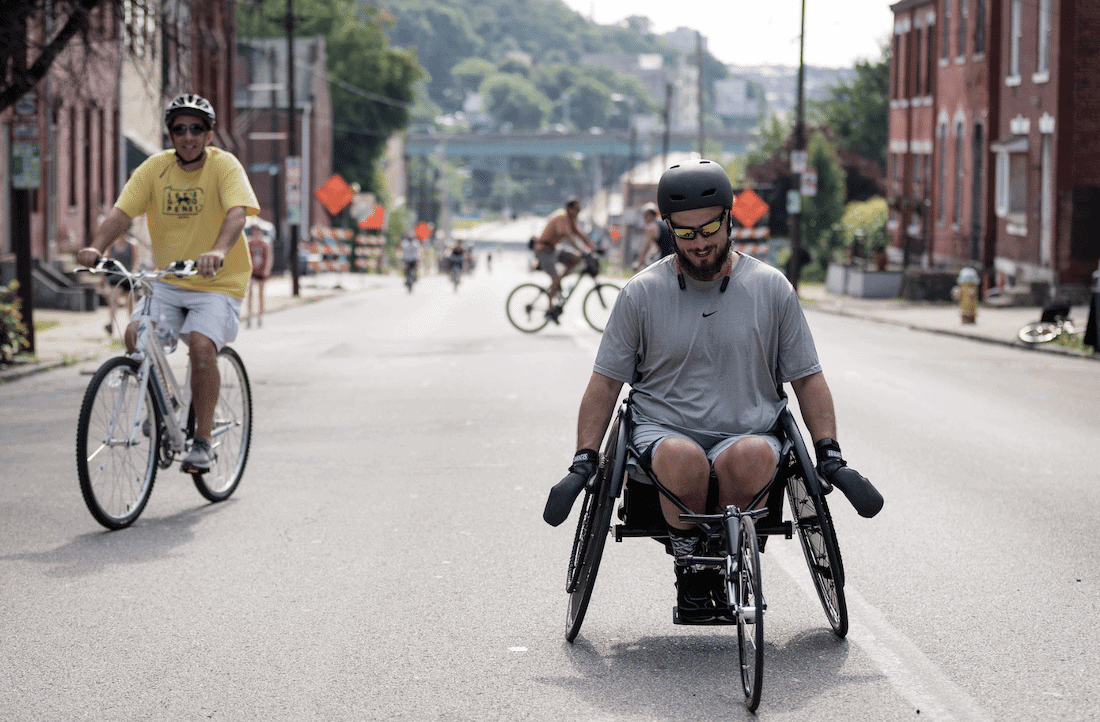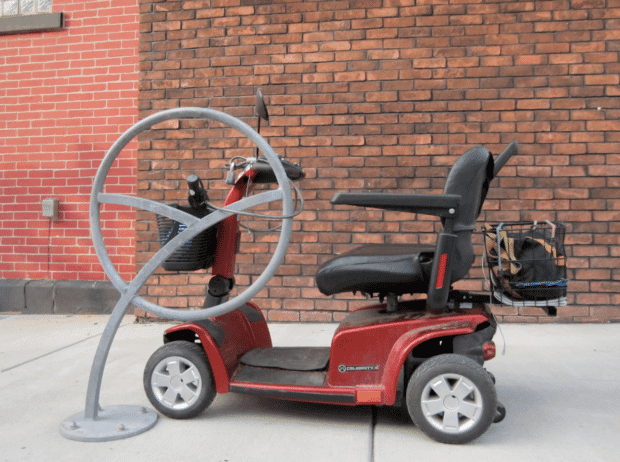
How a space is designed– and who gets to navigate it– speaks volumes about whom that space was designed for, whether intentional or not.
by BikePGH Staff Contributor – Christine Yockel
Anyone I encountered between late December 2023 and February 2024 knows that I was listening to, or had recently finished, the Audiobook copy of What Can a Body Do by Sara Hendren. The book first came to my attention on an episode of the podcast On Being, after which I immediately added it to my requests on Libby.
And while reading this book hasn’t made me an overnight expert on disability rights, I have become increasingly fascinated by the psychological, anthropological, and sociological aspects of the built environment — how we humans both create and respond to the engineered world around us.
First and foremost, the language we use about the ability to interact with a space shines a light on our relationship with it. In this book, the author starts off by acknowledging the different labels used by people with disabilities, and why.
In this book, I’ll use disabled and also people with disabilities interchangeably; I’ll also use nondisabled or typical in place of normal. Many people use and claim disabled for the same reasons…not to describe the state of [their] body but to keep alive in the cultural consciousness the enduring reality of a disabling world.
– Sarah Hendren, What Can a Body Do?
After establishing thoughtful reasoning for her word choices, Hendren further explains that language changes with time and culture. And with that, every human has their own word choice preferences– If you want to know a person’s preference on how to refer to them, simply ask.
Further, author Sara Hendren kindly and curiously asks the reader to consider the following:
- Able-bodiedness is a temporary state that only some of us have the privilege to experience
- Spaces and tools are more often than not designed for a singular body based on the aggregate number of many averaged factors: Humans come in a wide variety of shapes, sizes, and these factors fluctuate even within an individual over time and circumstance.
- The entirety of the built environment exists to allow humans to overcome environmental obstacles, designing spaces and tools that accommodate the widest range of bodies and abilities will be able to be used by the widest range of bodies and abilities

All of these statements are self explanatory. And yet, applying them to how we actually create a world that’s accessible to folks whose bodies fall outside of what statistics suggest is the “average” human body… that’s where you’ll find the barriers. When “average” is usually considered male, of a certain height, age and ability to move their bodies, then designing spaces that instead accommodate the widest range of bodies and abilities is often considered “exceptional” or an “accommodation,” rather than an expected norm.
This blog is made possible thanks to the support of our members and donors. Join us!
Chapter by chapter, Hendren provides examples of design that demonstrate how adaptable and innovative humans have had to be to navigate their independence and interdependence in a world that simply wasn’t built with them in mind. Examples include:
- A new father who created a contraption from found household objects that allows him to change his baby’s diaper without his prosthesis.
- A man who is designing his home to allow him to age in place as independently as possible for as long as possible as his body succumbs to ALS.
- And, larger scale systemic design adaptations– like the DeafSpace designs of Gaudellet University in DC, and curb cuts and other accessibility standards we often take for granted thanks to the tireless work of disability rights advocates like Judith Heumann whose efforts lead to the Americans with Disabilities Act – ADA – of 1990.
This book simultaneously showed the ubiquity of human engineered obstacles that make the world more difficult to get around (where we know better but don’t always do better) as well as the hope in the fact that the realm of what’s possible is so beautifully vast.

How do we bring this knowledge home to Pittsburgh?
How do we imagine a future that will better meet the full range of our collective needs in public and private spaces?
First, we can and must design public infrastructure that works for a wider range of people than the narrow “average.” It takes some creativity to do so, but it’s neither impossible nor a burden to do so when inclusive, creative thinking and planning is applied.
“Nothing about us without us.”
James Charlton
A few local resources specific to this idea and connected to BikePGH’s mission include:
- POGOH has their Adaptive Bike Fleet available to rent beginning in May this year
- Achieva is working locally to advocate for and support those living with disabilities.
- Open Up (3711 Butler St, Pittsburgh, PA 15201) is a community space that centers folks with disabilities to ensure everybody can benefit from mindfulness and movement. “Open Up’s mission is to teach mindfulness tools through movement and art practices that center people living with disabilities. Our programs are open to all who identify as having a disability and those who do not. They are for everyone.”
- And, always and as ever, BikePGH urges you to keep sidewalks clear, make 311 requests (and boost those others have made!) where safe connections are either nonexistent or impassable, and join your local bike and pedestrian committee to continue our work pushing for Complete Streets all over the city.
Pittsburgh ADA – In the News
Also, last week (April 22, 2024), the City of Pittsburgh announced a contract for the first ADA Transition Plan since 1992:
“The 1990 Americans with Disabilities Act requires municipalities to adopt a Transition Plan to identify obstacles limiting access to programs, services, and activities by persons with disabilities. The City selected [Precision Infrastructure Management] PIM because they are an industry leader in Municipal Asset Management and ADA Transition Plans, with a specialty in right-of-way infrastructure, facilities, and parks.”
“The ADA Transition Plan will happen in two phases, starting with a self-evaluation led by PIM, of the City’s streets, facilities, parks, programs, and services to identify issues. In the second phase PIM will work with the Office of Equal Protection and the City County Task Force on Disabilities, and other disability advocates, to create a transition plan, with significant community input, in order to make recommendations on how to resolve any issues identified by the self-evaluation.”
We look forward to seeing this plan in action to help make our City more accessible for all.
More resources
–
The TL;DR is everything that is human built or human made is engineered for bodies to exist in a space with an advantage they were not created with. How a space is designed and who gets to navigate it easily speaks volumes about whom that space was designed for, whether intentional or not.
